JHP Newsletter - 2007, No. 6, 27 October
Greetings from Simon's Town, South Africa. I've recently completed a very successful James Hager Photography photo safari in Kenya and am now on a five-week stay in South Africa on my own.
Equipment: Canon EOS 1D Mk III
My new Canon EOS 1D Mk III was both a pleasure to have and frustrating to use in Kenya. It was a pleasure because the improved performance at high ISOs compared to the Mk II let me capture images that I wouldn't have tried before. Another plus is the greatly-improved battery life. I only had to charge the battery twice during the trip, and was able to shoot about 6500 images on each charge! The biggest frustration with the Mk III is that not all of the 45 AF (auto-focus) sensors can be selected individually like they can with the Mk II. With the Mk II, it was very convenient to compose an animal portrait with one of the 45 AF sensors positioned on the animal's eye and then focus using just that sensor. With the Mk III, I've either had to compromise the composition a bit to get one of the selectable AF sensors on the eye or compose more naturally and focus on the bridge of their nose or some other "close-enough" point to their eye. Another frustrating thing about the Mk III is that it sometimes has trouble finding the right subject. Several times, like when shooting a bird in short grass (with the 500 f4 and 1.4x II attached), where the subject was obvious and with the Mk III set up to automatically select any of the 45 AF sensors, it would either focus on the background or cycle between the subject and background even though the center focus point was centered on the subject to help give it a clue what I was interested in. On the whole, the Mk III is an improvement over the Mk II, and I would never go back to using a Mk II as my primary body.
Travel: Kenya
My recent three-week James Hager Photography photo safari in Kenya was a big success, and our cat encounters were especially good.
The safari started with four nights in Samburu National Reserve which is roughly in the center of the country and provides an opportunity to shoot some unique species. I was able to get some nice shots of the Biesa Oryx, Gerenuk, Grevy's Zebra, and Vulturine Guineafowl. Waterbuck are common along the Uaso Nyiro River, and one male (below left) posed very nicely one morning in a great backlit setting. Birdlife is plentiful, and we had an exceptional encounter with a Long-Crested Eagle (below center). We were able to work with the bird as it moved from perch to perch in different trees, each time getting closer to it, before it finally tired of us and flew away. One of the most exciting encounters in the park was of two leopards — a male and a female courting each other. The female went up a tree and got cornered by a troupe of Olive Baboons. (A group of baboons can kill a leopard, and will do so to prevent the leopard from having an opportunity to kill one of their babies.) While the female was cornered in the tree and was being harassed by the older males, the rest of the troupe generally watched on the ground. (Think a Roman sporting event). There were several really small infants, and one mother and infant provided some great shooting opportunities (below right).
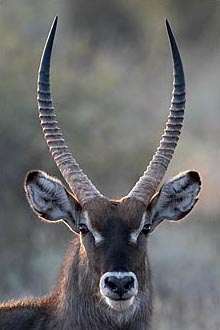
1/125 sec, f8, ISO 640
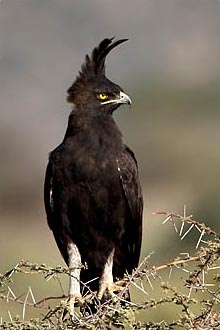
1/500 sec, f8, ISO 320
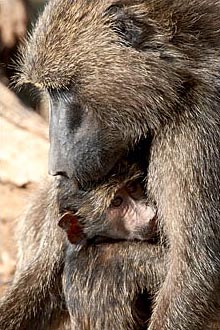
1/350 sec, f8, ISO 400
Then we spent two nights at Lake Nakuru National Park, mainly to shoot the thousands of Flamingos that feed there. We spent one whole morning parked by the shore next to a large flock where we could shoot individuals (below left) and groups standing in the water and also flying by. We were treated to a group of hyena that came down to hunt flamingos too which was a first for me. The park is known for the large population of White Rhino, and we had several opportunities to shoot them. Surprisingly, we had two opportunities to shoot the much rarer Black Rhino (below right).
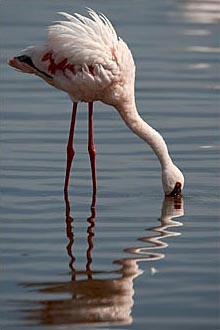
1/750 sec, f8, ISO 125
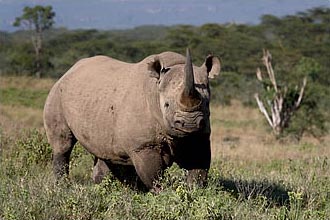
(at 184mm), 1/500 sec , f8, ISO 200
Then we spent 12 days in Masai Mara National Reserve, with four nights in the Lower Mara, four nights in the Mara Triangle, and four nights in the Upper Mara. Our cat encounters in the Mara were exceptional! In the Lower Mara, we watched a mother Cheetah take down a baby Thompson's Gazelle. Well, we watched and shot it as it started the chase, and the actual take-down was blocked by another vehicle. We then watched and shot it carry the still-alive baby towards it's two-month-old cub (below left), and then watched and shot the cub learning to kill the baby Tommy (below center). The cub didn't quite know how to kill the gazelle and soon lost interest. The mother eventually killed it before eating some herself and then the cub ate some. It was an awesome experience to watch and shoot! Another highlight was finding a recently-killed Thompson's Gazelle up in a tree in the Upper Mara one afternoon. The Leopard that had killed it and put it up there for safe keeping returned and we were able to shoot the Leopard on the ground in the grass and when it went down to the nearby stream to drink. Then it climbed up into the tree and started to finish off the Tommy! It must have been annoyed by the vehicles that had arrived, so it drug the Tommy even higher into the tree which provided a very nice shooting opportunity (below right).
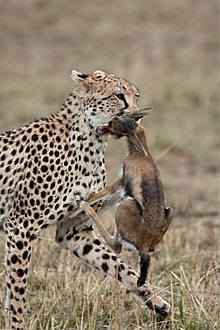
Baby Thompson's Gazelle
1/250 sec, f8, ISO 320

Baby Thompson's Gazelle
1/350 sec, f8, ISO 400
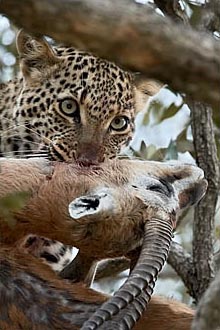
Male Thompson's Gazelle
1/90 sec, f6.7, ISO 800
Servals are very rare small cats, about twice the size of a domestic cat. On my last trip to Kenya, I only saw one Serval and wasn't able to shoot it. On this trip, I saw and photographed three Servals! The first was in the Lower Mara, the second was in the Upper Mara (below left), and the third was a cub in the Upper Mara! We found the cub atop a termite mound that was being used as a den. After a while, the little guy got down and explored the area around the termite mound (below center).
We did well with lions, and spent two mornings in the Lower Mara with a pride of lions that had four young cubs. My favorite lion image was of a male in the Upper Mara licking his chops after feeding at a zebra kill (below right).
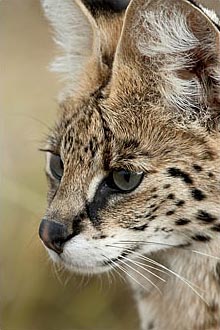
1/125 sec, f8, ISO 640
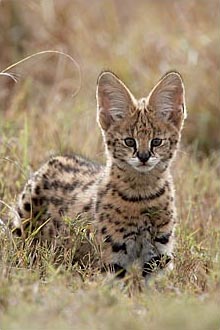
1/500 sec, f8, ISO 400
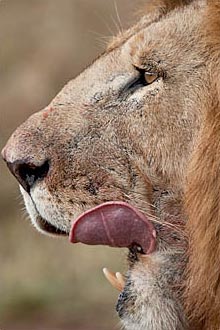
1/350 sec, f8, ISO 500
We spent one morning in the Upper Mara with a Cheetah mother and two four- to six-month-old cubs. The mother stopped to groom one of the cubs, and I was able to capture the image below-left that has the highest "aw" factor of the trip.
Baby Topi were in abundance while we were in the Mara, and I had never seen so many before. While shooting a large group of mothers with calves in the Mara Triangle, two males started fighting (below right) in order to determine who would sire the next round of calves.
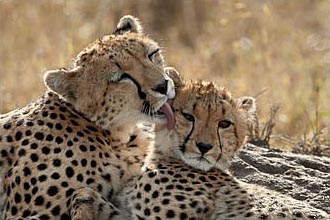
1/250 sec, f9.5, ISO 250
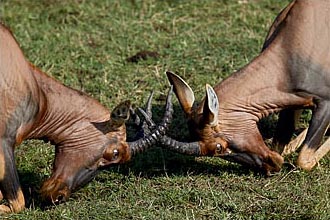
(at 276 mm), 1/500 sec, f8, ISO 250
I'll tell you all about South Africa in a few weeks.
Take care, and happy shooting.
— James
James Hager Photography :: www.jameshagerphoto.com




